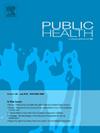Adherence to the EAT-Lancet diet reduces the risk of renal cancer: Results from a population-based prospective study
IF 3.9
3区 医学
Q1 PUBLIC, ENVIRONMENTAL & OCCUPATIONAL HEALTH
引用次数: 0
Abstract
Objectives
The EAT-Lancet diet (ELD) has shown potential in reducing obesity and type 2 diabetes, both of which are closely associated with the development of renal cancer. However, the specific relationship between this dietary pattern and renal cancer remains largely unexplored. This study aims to address this gap in knowledge by investigating the association between ELD adherence and renal cancer risk.
Study design
A population-based prospective study of 101,755 American adults from the Prostate, Lung, Colorectal, and Ovarian (PLCO) Cancer Screening Trial.
Methods
Cox proportional hazards models were utilized to estimate hazard ratios (HRs) and 95 % confidence intervals (CIs) for the association between ELD adherence and renal cancer risk, adjusting for potential confounders. Restricted cubic spline plots visualized the dose-response relationship. Subgroup analyses evaluated potential effect modifiers, and sensitivity analyses assessed the robustness of findings.
Results
Over 899,337.5 person-years of follow-up, 446 cases of renal cancer were identified. In the fully adjusted model, a significant inverse association was observed between higher ELD adherence and renal cancer risk (HR for highest vs. lowest quartile: 0.65; 95 % CI: 0.49–0.88; P for trend = 0.002). A restricted cubic spline plot revealed a nonlinear, inverse dose-response relationship (P for nonlinearity = 0.046). Subgroup analyses showed consistent findings across participant characteristics. Sensitivity analyses further reinforced the robustness of the primary association.
Conclusions
In this large prospective study, adherence to the EAT-Lancet diet was inversely associated with the risk of developing renal cancer, suggesting the potential benefits of this dietary pattern in mitigating renal cancer burden.
坚持EAT-Lancet饮食可以降低患肾癌的风险:一项基于人群的前瞻性研究结果
EAT-Lancet饮食(ELD)已经显示出减少肥胖和2型糖尿病的潜力,这两种疾病都与肾癌的发展密切相关。然而,这种饮食模式与肾癌之间的具体关系在很大程度上仍未被探索。本研究旨在通过调查ELD依从性与肾癌风险之间的关系来解决这一知识差距。研究设计:一项基于人群的前瞻性研究,来自前列腺、肺、结直肠癌和卵巢癌(PLCO)筛查试验的101755名美国成年人。方法使用scox比例风险模型来估计ELD依从性与肾癌风险之间的风险比(hr)和95%置信区间(ci),并对潜在混杂因素进行调整。限制三次样条图显示了剂量-反应关系。亚组分析评估了潜在的效应调节剂,敏感性分析评估了研究结果的稳健性。结果在899337.5人年的随访中,发现了446例肾癌。在完全调整的模型中,观察到较高的ELD依从性与肾癌风险之间存在显著的负相关(最高与最低四分位数的HR: 0.65;95% ci: 0.49-0.88;P表示趋势= 0.002)。限制三次样条图显示了非线性的逆剂量-响应关系(非线性P = 0.046)。亚组分析显示了参与者特征的一致发现。敏感性分析进一步加强了主要关联的稳健性。结论:在这项大型前瞻性研究中,坚持EAT-Lancet饮食与患肾癌的风险呈负相关,表明这种饮食模式在减轻肾癌负担方面具有潜在的益处。
本文章由计算机程序翻译,如有差异,请以英文原文为准。
求助全文
约1分钟内获得全文
求助全文
来源期刊

Public Health
医学-公共卫生、环境卫生与职业卫生
CiteScore
7.60
自引率
0.00%
发文量
280
审稿时长
37 days
期刊介绍:
Public Health is an international, multidisciplinary peer-reviewed journal. It publishes original papers, reviews and short reports on all aspects of the science, philosophy, and practice of public health.
 求助内容:
求助内容: 应助结果提醒方式:
应助结果提醒方式:


